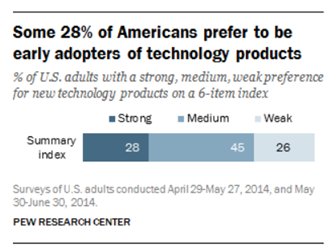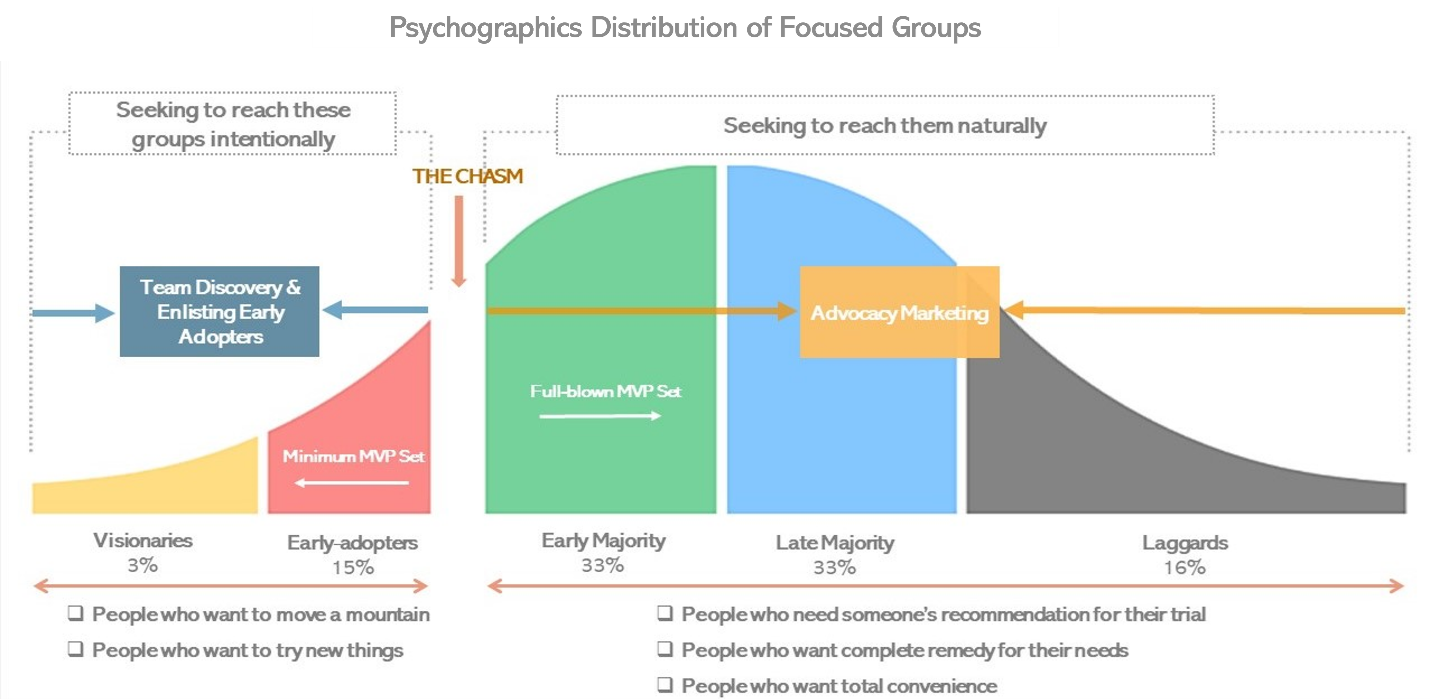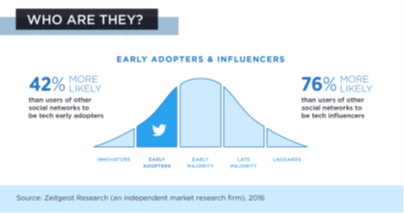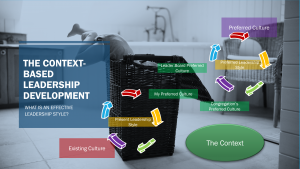How can we intentionally reach early adopters? While early adopters play a crucial role in establishing societal relationships, culturally-competent early adopters might be scarce in your congregation. When your ministry has a practical mechanism to get meaningfully connected with them, there would be a greater chance for the success of your community engagement projects. Why? Everett Rogers pointed out in 1962 with the “Diffusion of Innovation” theory that early adopters see opportunities before they are there, and they are willing to experiment to grab them. He stated they make up about 13.5% of the population.
 According to Pew Research Center survey data, about 28% of Americans are ‘strong’ early adopters of technology. Consider that the Coronavirus pandemic has forced almost everyone to adopt different technologies and new ways of living. Their make-up in the US population should be more now than the figure shown in the diagram of the psychographics distribution of Focused Groups.
According to Pew Research Center survey data, about 28% of Americans are ‘strong’ early adopters of technology. Consider that the Coronavirus pandemic has forced almost everyone to adopt different technologies and new ways of living. Their make-up in the US population should be more now than the figure shown in the diagram of the psychographics distribution of Focused Groups.
They have the following known traits:
- They understand the problem they’re trying to solve and are passionate about finding a solution.
- They are willing to try out a new solution that is not even fully developed or mature and provide the best constructive feedback to improve it.
- If the new solution remedies the problem or deadens their pain, they embrace the solution with royalty and then prominently influence others with similar issues to adopt the resolution.

You can deduce the following steps to reaching them by exploring these traits and reason inductively why they commonly show a particular behavioral pattern. The first step is to develop a community engagement project based on the underserved need of your community. Churches have often, if not always, started a new ministry based on a person’s aspiration. Encouraging and motivating people through their aspirations is a beautiful thing. However, today’s ministries involve much more than that. The aspiration-based ministry often comes with invalidated assumptions that might surprise you later with a high price tag. You probably must invest your resources for months, if not years, to implement your ministry around the aspiration. After all, what is waiting for you is the shocking reality that there is not enough demand for your ministry to sustain due to the ever-fast changing landscape of your local community. A rapidly changing society in today’s culture requires you to take a new approach to reach new people in your community. It would be best if you learned to develop a ministry in a short timeframe, presenting strong value propositions focusing on alleviating their pain or solving their issues. Such a ministry value proposition makes the initial point of contact with early adopters, who are actively searching for a solution to their life problems, possible in the early hood of the ministry development.
Now, where can we find them? It is relatively simple. We will use both inward and outward tactics to seek them where they are. Since they are passionate about finding solutions to their problems, they are online searching for an answer. Your church website should have a webpage professionally designed to promote any individual community-based ministries. You don’t pitch your vision or mission on the page. Instead, state the issues and the solution you are trying to present with your program. Don’t forget to research the keywords that will invite those online searches. It would help if you populated the selected keywords on your web page associated with the problems you are trying to solve. I have written an article about Keywords Research, and please find it here. It would help if you prepared a call-to-action button with substantial content that encourages visitors to leave their contact information for those searches that will land on your web page. You shouldn’t demand too much information at this initial contact. Probably their email contact and areas of their interest will be sufficient. A series of email campaigns carefully predesigned through your ministry content marketing should follow the initial point of contact. I will post on the ministry content marketing soon.
Since early adopters are engaged with their network of people as influencers, primarily through social media, you should consider pushing your ministry value proposition to the social network. The easiest way of outward tactics should be buying social media ad time for specific demographics. The push-based discovery model for finding them works well since you can present the solution even before they can locate one. Churches can use Facebook’s targeting algorithm as part of their ads marketing. Another effective outward tactic is to seek existing online groups that target the same audiences as yours. You will be stunned that many Facebook groups or Meetup groups in your local areas are already trying to present similar value propositions aligned with yours. Join those online groups, engage with them, share the issues of your community, raise your ministry value propositions, and ask them to co-organize a program for the sake of your community. The above tactic shows how you develop a community-based ministry in the digital culture.
 The second step is not to waste your resources developing a full-blown ministry without validating your assumption. The water-fall approach to ministry strategy development is no longer working for churches. Instead, you better take advantage of adopting the minimum viable ministry development strategy, knowing that early adopters are willing to try out your program with a minimum viable value proposition as long as it tries to reduce the pain from their problems. Early adopters are also willingly participating in your community engagement programs as co-organizers. If you invite them to share their journey with your minimum viable ministry, they will give you their best constructive criticism. Therefore, it is crucial to implement a ministry pilot project targeting a few early adopters. The goal of your pilot ministry should focus on getting the objective feedback and pivot your ministry into the next round of your ministry loop by reflecting on the feedback and modifying your ministry value proposition as you validate and eliminate certain assumptions. If you are interested in knowing about the minimum viable ministry development, please visit here. Validating those hidden assumptions in your ministries early as possible is crucial to the maximum ROI. Please use this link to an intriguing YouTube video, “The Marsh Challenge,” that could explain why our community engagement has not been effective if they are not.
The second step is not to waste your resources developing a full-blown ministry without validating your assumption. The water-fall approach to ministry strategy development is no longer working for churches. Instead, you better take advantage of adopting the minimum viable ministry development strategy, knowing that early adopters are willing to try out your program with a minimum viable value proposition as long as it tries to reduce the pain from their problems. Early adopters are also willingly participating in your community engagement programs as co-organizers. If you invite them to share their journey with your minimum viable ministry, they will give you their best constructive criticism. Therefore, it is crucial to implement a ministry pilot project targeting a few early adopters. The goal of your pilot ministry should focus on getting the objective feedback and pivot your ministry into the next round of your ministry loop by reflecting on the feedback and modifying your ministry value proposition as you validate and eliminate certain assumptions. If you are interested in knowing about the minimum viable ministry development, please visit here. Validating those hidden assumptions in your ministries early as possible is crucial to the maximum ROI. Please use this link to an intriguing YouTube video, “The Marsh Challenge,” that could explain why our community engagement has not been effective if they are not.

Early adopters are not like other groups in the psychographics distribution who need someone’s strong recommendation based on the actual user experience. They don’t even expect a complete remedy to their problem nor demand total convenience with a professional user experience with a delightful factor (surprise features and benefits). They tend to show their royalty if your ministry program is a new attempt to solve their problem. But this royalty can be a double-edged sword. If there exists a better solution, they are willing to move on to the newer one. So, it is crucial in the early stage to invite them as co-creator of the problem. Your role in the community engagement project is now a community organizer who is intentionally onboarding them to the organizing team. Churches have known for great teamwork among members with strong faith convictions who share common beliefs and religious values. But the world that is supposed to be your parish has changed significantly since the digital revolution. Churches now must learn to collaborate with non-church members simply for the sake of their community. Early adopters can be your community connectors. When you create a safe space for them to initiate their spiritual journey with you, they will bring in the cultural competencies needed for successful community engagement. They also influence other new people to join your ministries, like the early majority and late majority. When this happens, churches will enjoy the virality effects of the digital culture and could multiply the ministry of reaching new people in your community.






